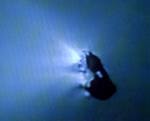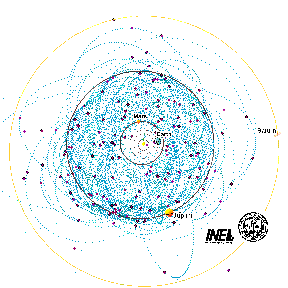 click
for 6 kb image
click
for 6 kb image
It was black because it was covered with a dirty, tar-like material. Their sensors found it was "kerogen", CH2.5 polymer, which is something like oil shale.
About 150 comets, between the sun and Jupiter, are always there, but dark. They move much more slowly than comet Halley or comet Hale-Bopp. These Jupiter-family comets, also known as Periodic Comets, and most have periods between 3.3 years and a 15 years. Some tens of percent are accessible in some sense. Calculations showed that the mission velocity needed to bring back ten-thousand ton payloads from these periodic comets to a captured orbit around Earth, using propulsive capture, is within what we believe is engineerable using nuclear heated steam rockets.
If you would look out into the clear night sky, you should see a sky-full of comets. You would be scared if suddenly you could see them. But you don't see them. They are dark 99% of the time. And when they show their tail, you typically need a telescope to see them. They are much smaller than comet Halley or comet Hale-Bopp.
When comet Halley came by during 1988 the Europeans (NOT nasa) took
close up pictures of it. They saw a black part that was much bigger than
what they thought the comet should be. They discovered a surprise: the
comet was 4 times bigger in size than they had thought. That meant it was
4 cubed times more massive, or about 64 times.
 click
for 6 kb image
click
for 6 kb image
It was black because it was covered with a dirty, tar-like material.
Their sensors found it was "kerogen", CH2.5 polymer, which is
something like oil shale.
The Jupiter-family comets suspected of being similar in composition,
with perhaps less water ices. They are plotted as the dark diamonds
in the image below. The dotted orbit points are equi-spaced in time, so
that density of blue is chance of finding a comet. The comets are mostly
in the plane of the planets, called the ecliptic.
 |
| click here for 43 kbyte, more clear image |
These comets are made of about equal parts of a fine, black hydrocarbon
similar to dirty oil shale, fine silicate dust similar to clay, and water
ice.